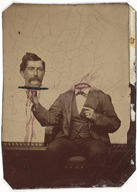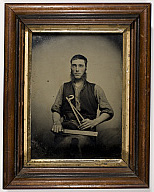Thanks to the Connections program, I used my PRC membership card to get in to the International Center of Photography (ICP) in New York city free. There were three shows of serious photojournalism and documentary photography by Susan Meiselas, Cornell Capa and W. Eugene Smith, which were all impressive and moving, and an extensive (150+ images!) show of tintypes called America and the Tintype. Before you read more, note that these shows close January 4, so get your butt over there.
Tintypes were to the late 19th century perhaps as polaroids were to the late 20th – democratic, cheap, widely available pictures that refelcted and also formed the culture.
The profusion of tintypes produced means that many are still floating around. See some results at google images, on flickr and also on ebay. There are even a few modern practitioners, such as John Coffer, who lives the full 19th century life of an itinerant tintypist.
 Although tintypes still required relatively long exposure times and the presence of a professional photographer, many images in this show display a looseness and playfulness that was surprising to me. I don’t really think of sticking your tongue out for a picture as something anybody did much until cheap instant film hit the scene. Don’t even get me started on the shenanigans enabled by flickr and youtube.
Although tintypes still required relatively long exposure times and the presence of a professional photographer, many images in this show display a looseness and playfulness that was surprising to me. I don’t really think of sticking your tongue out for a picture as something anybody did much until cheap instant film hit the scene. Don’t even get me started on the shenanigans enabled by flickr and youtube.
In one image the sitters frame their faces with their tennis rackets, staring through the catgut grids in their fancy sportswear. In another, a grown man sticks out his tongue and pulls his lower eyelids down.
One of the cover images for the exhibition shows one of the classic photo-manipulation tricks of the morbid set: holding your own severed head on a platter. Or in this case, on a line just drawn for the purpose. And enough hand-painted dripping blood for a teenager’s gory notebook margin doodle.
The ICP website shares about half the images in the show, a remarkable ratio, but they omit a few of my favorites. Notably, one in which two white men sit in chairs. Two black boys sit in their laps. The men look at the camera and the boys look at eachother, seeminly lost in a game of rock-paper-scissors, or perhaps exchanging a post-civil-war fist bump of victory.
In nearly every case, the identity of the photographer and the sitters is unknown. Some pictures survive in elegant frames, others as just paper. Some have extensive overpainting or tinting, some just a little or none at all.
In one of my favorites, a blacksmith poses with his tools, wild 19th century whiskers and all. His hands are visibly dirty but his cheeks have been tinted with a rosy glow. There’s a bright white bandage on this little finger.
M


Trackbacks/Pingbacks